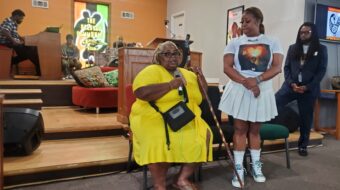
Eric Law teaches diversity. An Episcopal priest, he founded a consulting firm called the Kaleidoscope Institute to help other congregations move beyond the monochromatic culture of white Protestantism. He uses the image of an iceberg to help people understand that individual prejudices mostly live below the surface and out of sight. Like a chunk of ice floating in the sea, most of our biases reside in the unconscious, outside of our awareness. Until they don’t.
The blast of racial incidents that have hit the headlines recently didn’t come out of nowhere. As a Capital & Main series documented, they came from hate groups and blog sites located across the country. Not just in distant places like Philadelphia, where vandals damaged a Jewish cemetery, or Florida, where arsonists torched a mosque, or Indianapolis, where a group of Latino and black fourth graders who won a science competition were “showered with racial slurs by rivals and parents.” No, these things happen right here in California.
Attacks happen at Jewish synagogues and Islamic mosques, to Sikhs and Latino/as and African-Americans, as well as gays, lesbians and transgender people—anyone visible enough to be a target for someone’s unconsciousness.
These incidents have exploded because white and mainstream prejudice has been contained under the line of vision for several decades, and now the lid’s off. When I was a child an uncle often told funny stories in a “Mexican” accent. Everyone in the family laughed. Then he stopped. I remember my father asking him why. “Can’t do it,” he said. “Company said no.” Simple as that. Whatever he thought, the corporation he worked for as a salesman decided it was no longer in its interest for representatives to display overt acts of racial prejudice.
Sadly, President Trump himself uses racial dog whistles, and did so throughout his campaign. These phrases work because a huge, latent, unconscious racism lurks just under the surface of our social behavior, and a public figure—the president, no less—has encouraged us by example to set the demons loose.
He has had help along the way. The act of treating one another with respect and using appropriate language became denigrated as “politically correct” speech. So people began saying whatever they felt like without regard for the feelings of, or the impact on others. Some public intellectuals told us we live in a post-racial, diverse society—we didn’t need to pay attention anymore to what we said or how we characterized people not like us. Lawsuits claimed that it was white people who have been discriminated against, not the historically segregated or silenced.
During the last few decades, America’s demographics have changed as well. Those of us in California are aware of the ethnic turn because we know we no longer live in a state with a racial majority. Whites are not even a plurality. But that shift is happening across the country and will continue as the population ages. Among my cohort of 55 and older, 75 percent are white, but among 35-to-54-year-olds, whites drop to 61.5 percent. Among 18-to-34 year olds, the percentage of white people drops to 55.8 percent, and under-18-year-olds, to 51.5 percent. Those numbers came from 2015.
In a seminary class on racism held half a century ago, I learned that members belonging to a majority race begin to feel discomfort when their turf—whether a neighborhood, city, state or nation—becomes 17 percent ethnic minority. Around that threshold the invisible becomes visible, and the fear of being supplanted rises. The newly perceived threat to majority-group expectations begins a cycle of pushback and digging in.
“In polite company,” among political power brokers, that means changing the laws to make it more difficult for some people to vote. It means gerrymandering electoral districts to consolidate majority power. In raw terms, it draws people to the racist underground that attracts people who feel alienated, disenfranchised, powerless. Keep this going for a while, and the basic mores of the society shift. A Pew study found that a wide majority think that people are just too easily offended by language. Only among African-Americans does a supermajority feel that people in general need to be more careful about what they say.
Rebecca Todd Peters writes about ethics from a religious and feminist perspective. Recently she wrote, “Most white Christians are good people who do not understand themselves to be prejudice[d]. That’s one of the insidious things about prejudice—it is invisible to those who hold it.”
I know that as a white man, raised in the thick of prejudice, I have spent half a century consciously overcoming the lines of discrimination buried in my psyche from childhood. It requires a daily awareness—a conscious, spiritual discipline, if you will—and I will carry the bitterness of this struggle to my grave. Too many of us keep our racism beneath the surface, internalized. We let it loose at our peril, but to pretend it doesn’t exist is far worse.
Reposted courtesy of the author and Capital & Main.










